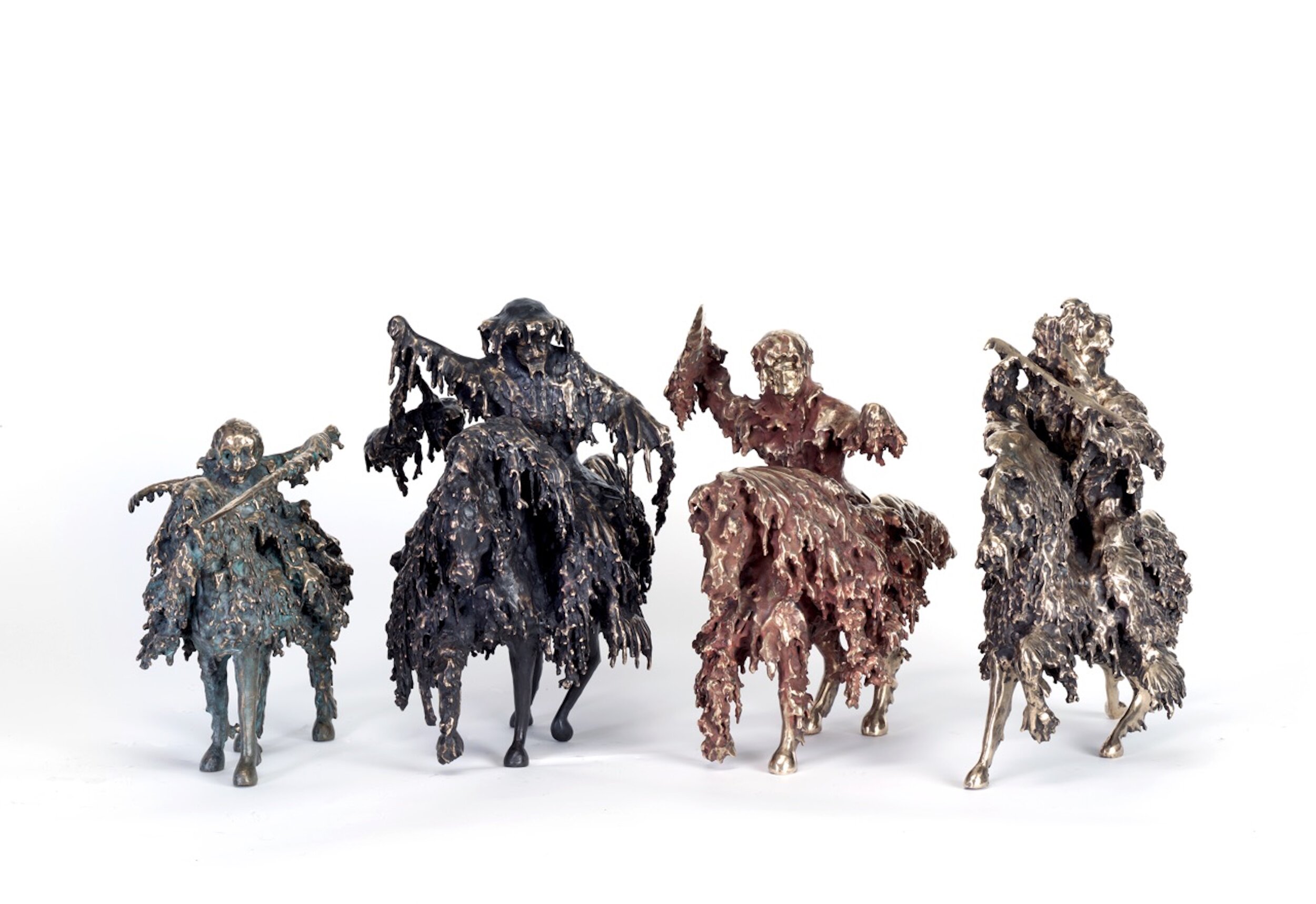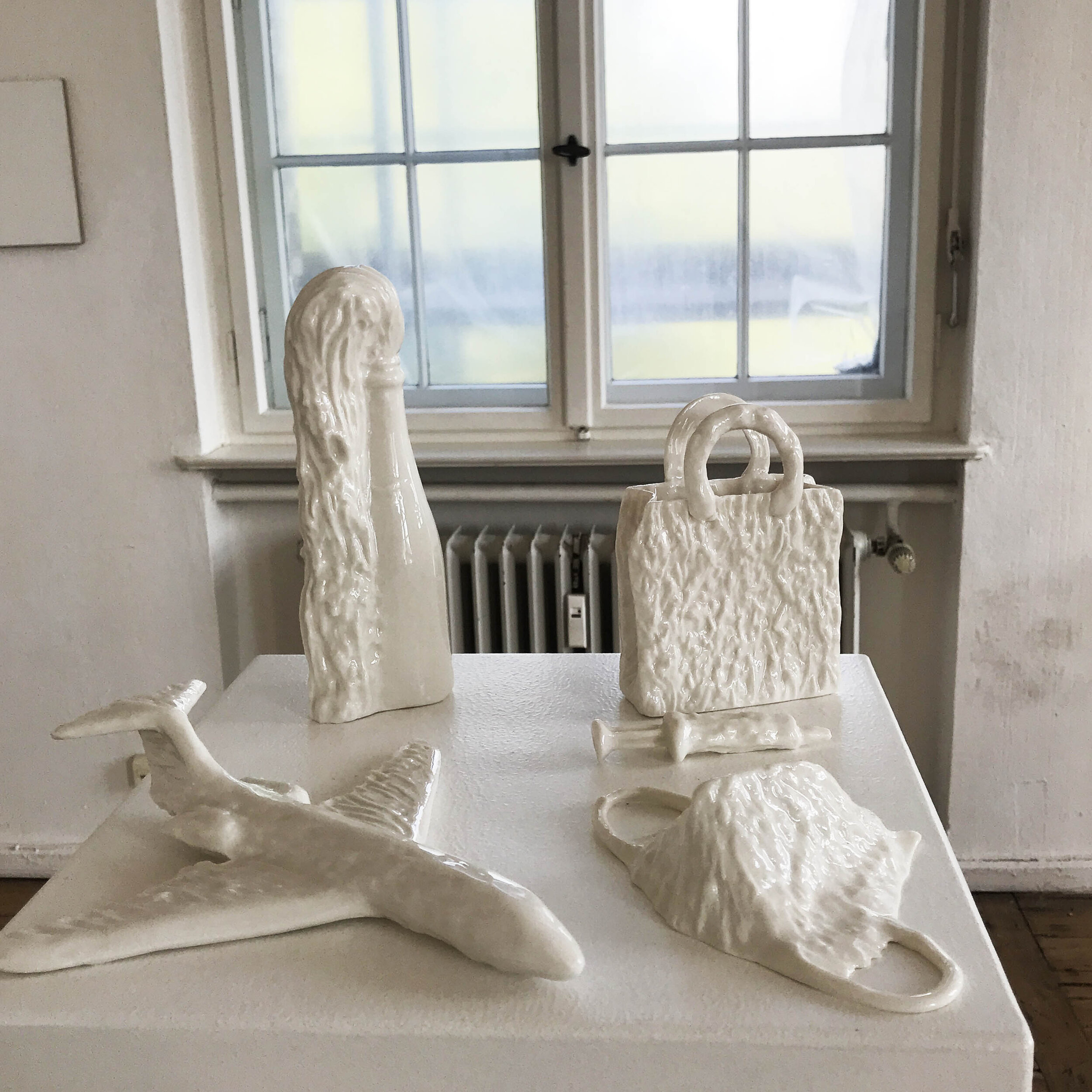
Studio Visit
OLIVIA BERCKEMEYER
Curator visits Berckemeyer in her Berlin studio to discuss the artist’s work, living in Germany, and plans for the future.
Olivia Berckemeyer is a Berlin-based sculptor who employs the lost wax casting technique to question institutional power. Her focus on bronze-casting allows her to address long-held associations, precisely bronze objects and figures as pieces that hold importance and permanence.
Over the past few years, Berckemeyer has begun creating sculptures with a broader range of materials, including porcelain and wax. Her work has been exhibited at Michael Fuchs Gallery in Berlin, Berliner Kunsthalle, the Museum of New Art in Detroit, the Hamburger Bahnhof Berlin, and Autocenter Berlin.
Interview by Semra Sevin
You recently showed your piece, Berghain, at the Wiederwerachen art fair. Can you tell us about it?
Berghain is a wax sculpture that examines and redesigns the ancient-mythological representation of the heroic statue as a figure of power and strength. At the same time, Berghain is an analogy of female sexuality in today’s question of identity. Today’s body image and its perfection displayed by influencers and the media focus on the outer shell and its interchangeability. The floral, lustful beauty of the male figure stands for power because of the Schopostiefel (boots of the police of the former GDR) and the steadfastness of the legs in cowboy style. The ideal body dissolves and turns into a hermaphrodite because of the floral sex of the Anthurie. I pour and drip the collective understandings of pathos concerning power and lust into the wax. The softness and fragility of the material are in juxtaposition to the stately monuments, which are designed to represent solidity and eternity.
The lava-like deformed surface thrown up by the dripping wax technique is an essential component to the ironic and critical questioning of representation itself. Here, the form becomes an anti-form inscribed in the sphere of “female art” and generates unease with the viewer. In relation to the decline of power and to the general views of the autonomy of the ‘feminine’ in the discussion around ‘feminine fluids.’ The forms of ambivalence are seen as rational but not clearly classifiable, and they are directed against a world view of logic and the male interpretation of symbols of power. This theme can be observed in anti-form art of the 1960s and 70s and is an essential component of my investigation into materiality and representation.
Berghain, 2021, wax dripping technique, wood, rubber boots, 47.25 x 15.75 inches
Your work includes bronze figures of ships, horse riders, and hands that look like melting wax. What is the core motivation for your practice?
The subject of my work is showing the two sides of things, their stagnation and their movement, simultaneously. I am also interested in the state of alienation and estrangement one can sometimes feel towards oneself. In a mirror, you perceive the physical unity that you do not feel in reality. Within our reflection, we identify with something that we are not: the ‘unified image of the body.’ The body at that moment physically exists at a location that we are not (namely the mirror). Thus the recognition within the mirror becomes an imaginary misjudgment and causes the subject to split into an “ideal self” and the “other self”; Quasi into the “me” and the “non-me.” These are the subjects and questions I reflect on, and that touch me deeply.
The leitmotif of my bronze figures is the desire for the ideal, victory, power, and strength. Moreover, eternity in status symbols and the alter ego (mirrored self) of status symbols stand for destruction, mundanity, evanescence, and the dissolution of things. This game of vanity is the subject of my works, which are mostly made of bronze - a status symbol for eternity, and yet they seem to be melting away and dissolving as a result of my initial wax dripping technique. The strong emphasis on the archaic in my work is not an attempt to flee time and reality but to accept the cycle of life; everything becomes finite.
Forward, 2014, Unique bronze casting using the lost wax method, 55 x 18 x 51 inches. Courtesy of the artist and Richard Gray Gallery
Apokalyptische Reiter (Apocalyptic Rider), 2013, unique bronze cast using the lost wax method, gold patina, 17.3 x 11 x 17.3 inches. Courtesy of the artist and Michael Fuchs Galerie
What interests you about the wax drip technique?
I am fascinated by the liquefaction of Bronze which is a solid and durable material. For me, it represents eternity. In this method, I drip the wax in layers upon layers. This is very time-consuming, and I make all the models myself, even if they are five feet high. I do not use negatives but only positive forms, using the technique of ‘cire perdue.’ This method was widely used by the artists of the Informel art movement because it brings out a personal signature of each artist.
What came first, your concept or the drip technique?
My work has always dealt with power, triumph, and the poses humans and animals take when embodying those things. Since 2004 I have been forming, casting, and dripping with wax the big and powerful symbols of the western world. I am challenging their absoluteness and permanence through the softness and fragility of wax. I apply a patina of lava, silt, and sugar melt to my objects, and in this way, the knights, boats, and airplanes, with all their pretentious “poses” of power and heroism, melt and liquify.
Why did you choose Berlin as your art base?
Berlin is the most important city in Germany for art. Moreover, Berlin is the city that is conceptually closest to my art because it changes all the time, and Berlin is constantly in movement. I get inspiration for my work in this city. Here, you have the old and the new next to each other. The people come and go, making Berlin a transient city. Houses are torn down, and new ones are built. When I first arrived in the city, the “Palast der Republik” was still a symbol for the former DDR. Today they rebuilt in its place the old city castle. In the past, you had the ‘Tacheles,’ ‘Tresor,’ and ‘Cookies,’ and now you have King Size Bar and Berghain. It evolves constantly.
How do you see the future of the city and the future of art in Berlin?
In Berlin, people invest more in real estate than in the arts and artists. More and more high-priced building projects emerge, and the artists have less and less space. Yearly, 350 artist studios are closed down in Berlin. The investment in art nowadays occurs more and more within the secondary market or the established galleries that invest into very costly international art fairs. Berlin will, of course, continue to remain a magnet for artists as it is a very open-minded city, which has many possibilities. I wish Berlin luck.
Studio view of Berkemeyer’s White Dreams series
What projects are you working on right now?
I recently finalized the project, Art to Go, in which I’m creating bronze iPhones. Currently, I am working on an oscillating white porcelain series, White Dreams, inspired by Brave New World by Aldous Huxley and Rom Blicke by Rolf Dieter Brinkmann. With these beautiful, fragile, and noble sculptures, I refer to the abuse of nature, animals, and humans through scientific achievements. These are the prestigious consumer goods that the media implants in us and uses as forms of surveillance and environmental destruction. I create these images of power as beautiful, white porcelain figures to reveal the contradictions. For example, the famous Porsche Cayenne is the car that every wealthy person drives in Germany, but it uses the same diesel as other cars and the same people driving this car shop at the organic store. The same goes for the airplane, the yacht, etc. I model these vanitas symbols in wax to give them a melting patina, casting their mold in porcelain. My intention is to shape these environmental destroyers into a beautiful and brutal yet minimalist, white toy world.
What are your future plans?
To be exhibited at MoMA in New York City!

Olivia Berckemeyer in her Berlin studio



